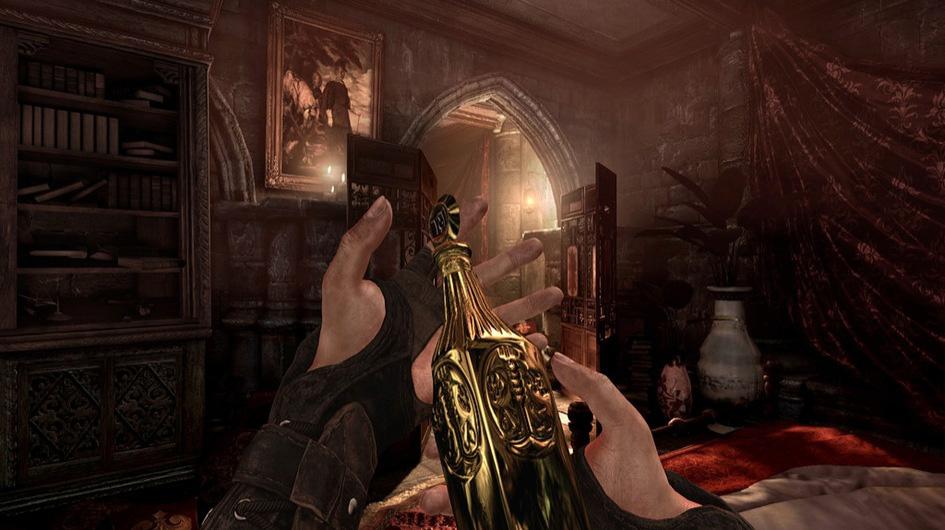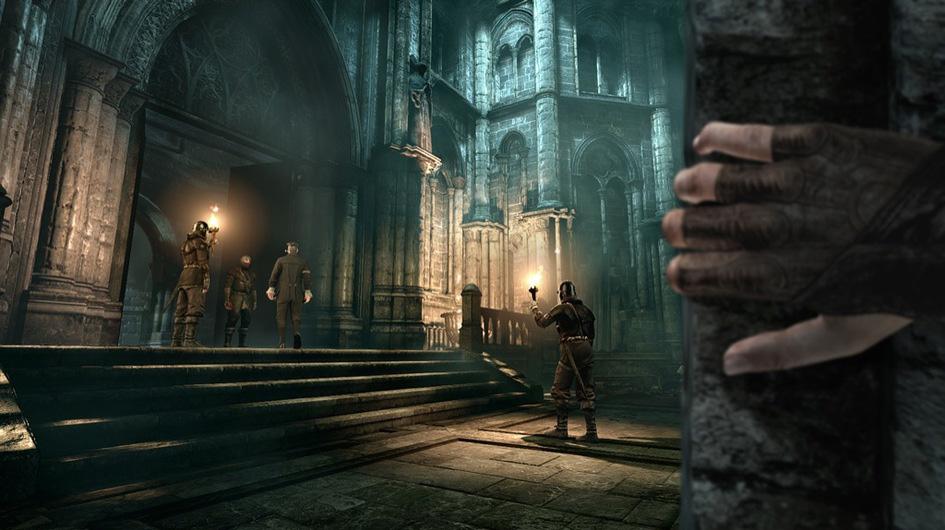For whatever else you want to say about it, Thief certainly lives up to its name. Eidos Montreal’s 2014 revival of the long-dormant series returns the playable protagonist Garrett to “The City,” which turns out to be a playground of parkour trick lines and treasure-laden nooks and crannies. There’s a story to give the game some structure, but our recent hands-on preview primarily concerned itself with demonstrating the open-ended nature of Garrett’s cat-burgling.
Story/Concept
Night and the city. We’re still not entirely clear on the driving series of events that guides Garrett’s journey through The City. The master thief returns to his old stomping grounds, only to find it overrun by a bunch of jerks in the employ of the tyrannical Baron. So he sets up shop in his old clocktower hideout and resumes his thiefly ways.
Garrett is still a relative newcomer when our demo opens. He’s been in The City long enough to get back to the clocktower, but he’s going to need some big scores to fill the empty frames, display cases, and pedestals that are scattered throughout the hideout. Fortunately, Garrett has a contact named Basso waiting in a nearby tavern with a list of potential marks. That’s where we find ourselves when we slip through the clocktower window and off into the open city.
Gameplay
Sneak thief. While Garrett is capable enough in combat with his handy blackjack in one-on-one encounters, he’s really built more for sliding through the shadows unseen. You’ve always got a sense of how visible he is thanks to a small moon icon in the bottom left corner of the screen; the brighter it is, the easier you are to spot. Crouching helps with concealment, and a handy “swoop” maneuver – a quick, stealthy dash in the direction of your choosing at the press of a button – is vital for slipping from shadow to shadow.
There’s unexpected beauty to be found in The City’s shadowy, cobblestone streets and alleyways.
Garrett is light enough on his feet that he’s able to move past most obstacles with ease using the left trigger, which also doubles as a run button. Simply hold it down and you’ll automatically vault over low obstacles, scale reachable ledges, climb ladders, and leap across short gaps. There’s a bit of a learning curve here as you figure out how pathing works in the game. The trick is to look for objects that have a light-blue sheen; this is your indicator that a certain surface can be scaled or leapt to.
On the job. The reward for meeting up with Basso is a list of targets for Garrett to rob. These are capital-J Jobs that each have a minor story attached to them. You might be asked to steal a pocketwatch belonging to some local jerk or relieve a beautiful bachelorette of a golden hand mirror given to her as a gift by one of her many suitors. Jobs can also be collected when you explore The City, such as one we collected when we inspected a guardpost log that pointed to a weapons stash for the local watch.
Exploration is key. You can set waypoints for Jobs you’ve collected that will point you in a general direction, but a lot of the time you’ll need to follow a specific route or perform some task in order to reach your destination. Purchasing a wire cutter allows you to interact with pulley-based control boxes that unlock doors and gates. You can also buy a ratchet that allows Garrett to crack open and squeeze through vents. A meter-managed Focus ability helps to highlight interactive bits of the environment, but successful thievery – whether you’re on a Job or just slipping through some poor shlub’s window – hinges on taking a measured approach.
Presentation
The naked city. Thief is a gorgeous game. The relentlessly dismal City isn’t exactly bustling with life – at least, it isn’t in the Stonemarket neighborhood that we spent our demo in – but there’s unexpected beauty to be found in its shadowy, cobblestone streets and alleyways. From the ragged beggars warming their hands over small fires to the play of streetlights stabbing through The City’s oppressive fog.
Takeaway
The more we see of Thief, the harder it is to make a case that it compares to Arkane Studios’ 2012 hit, Dishonored. For all of the surface gameplay similarities, Eidos Montreal’s efforts feel rooted to the spirit of the series of games that precede it. Garrett is no killer; he’s an agile sleight of hand artist whose survival hinges on cunning and maintaining a brisk trade in stolen loot.
Stay tuned for more on Thief as its February 25, 2014 release approaches.




